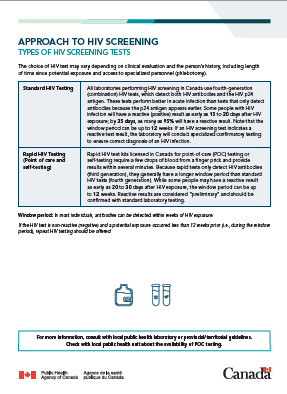Approach to HIV Screening

Download the alternative format
(PDF format, 80 KB, 1 page)
Organization: Public Health Agency of Canada
Date published: December 2020
Types of HIV Screening Tests
The choice of HIV test may vary depending on clinical evaluation and the person’s history, including length of time since potential exposure and access to specialized personnel (phlebotomy).
Standard HIV Testing
All laboratories performing HIV screening in Canada use fourth-generation (combination) HIV tests, which detect both HIV antibodies and the HIV p24 antigen. These tests perform better in acute infection than tests that only detect antibodies because the p24 antigen appears earlier. Some people with HIV infection will have a reactive (positive) result as early as 15 to 20 days after HIV exposure; by 35 days, as many as 95% will have a reactive result. Note that the window period can be up to 12 weeks. If an HIV screening test indicates a reactive test result, the laboratory will conduct specialized confirmatory testing to ensure correct diagnosis of an HIV infection.
Rapid HIV Testing (Point of care and self-testing)
Rapid HIV test kits licensed in Canada for point-of-care (POC) testing or self-testing require a few drops of blood from a finger prick and provide results within several minutes. Because rapid tests only detect HIV antibodies (third generation), they generally have a longer window period than standard HIV tests (fourth generation). While some people may have a reactive result as early as 20 to 30 days after HIV exposure, the window period can be up to 12 weeks. Reactive results are considered “preliminary” and should be confirmed with standard laboratory testing.
Window period: In most individuals, antibodies can be detected within weeks of HIV exposure.
If the HIV test is non-reactive (negative) and a potential exposure occurred less than 12 weeks prior (i.e., during the window period), repeat HIV testing should be offered.
For more information, consult with local public health laboratory or provincial/territorial guidelines.
Check with local public health unit about the availability of POC testing.
Barriers and Facilitators of HIV Screening
How Healthcare Providers Can Facilitate HIV Screening
Healthcare providers should take an active approach to HIV screening, as earlier diagnosis and treatment leads to better health outcomes. Individuals with positive results should be linked to treatment and care. Those with negative results may benefit from counselling on risk reduction and prevention measures.
Healthcare providers are encouraged to decrease barriers to HIV testing. These barriers may include:
- discomfort discussing HIV
- stigma and discrimination associated with risk behaviours
- lack of perceived risk of HIV infection
- fear of positive result and associated stigma
- limited access to HIV testing
To facilitate HIV testing, healthcare providers can:
- normalise the offer of HIV testing, making it part of routine care
- assure protection of the person’s anonymity and confidentiality
- offer an environment that is free of stigma and discrimination
- emphasize the benefits of early diagnosis and treatment
- provide information on risk factors for HIV infection, and prevention methods (e.g., pre-exposure prophylaxis or post-exposure prophylaxis)
- discuss testing options, including POC testing (where available) and self-testing
- when taking a sexual health history, keep it brief and relevant, as detailed risk assessments can deter people from seeking care
HIV self-testing and POC testing (where available) can facilitate uptake of screening. In addition, HIV self-testing provides an option for people who face barriers to accessing testing in healthcare settings.
Offering an HIV Test
In Canada, HIV testing is voluntary: the person is free to accept or refuse testing. When offering an HIV test, healthcare providers should ensure the individual understands:
- how HIV is transmitted
- the advantages (i.e., clinical and prevention benefits) and disadvantages of testing
- the right to refuse
- the follow-up services that may be offered
- that local public health will be notified in the event of a positive test result
- the public health benefits of disclosing their HIV status to current and future partners in the event of a positive test result, along with the benefits of partner notification to encourage previous and current partners to be tested
Note: Verbal consent is sufficient to proceed with testing.
Additional Resources
- Public Health Agency of Canada's HIV Screening and Testing Guide
- Government of Canada: HIV and AIDS for Health Professionals
- Canada Communicable Disease Report: An Overview of Recent Evidence on Barriers and Facilitators to HIV Testing
- Canada Communicable Disease Report: Canadian and International Recommendations on the Frequency of HIV Screening and Testing: A Systematic Review (PDF)
- CATIE - HIV Testing Technologies
Page details
- Date modified: